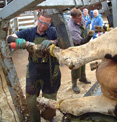Preventative foot trimming regime can save money

A low tolerance of lameness and an emphasis on prevention rather than cure has allowed a Somerset dairy farmer to significantly reduce lameness, with a potential saving of £37,440 a year.
Lameness has always been a priority at Steanbow Farm, Pilton, where Neil Christensen farms 500 dairy cows.
“In my mind, one lameness case is one too many,” he says. “Our tolerance level is zero.”
Lameness has always been actively observed, but recently the trimming routine has been changed, and with some success.
“Previously, cows were trimmed at drying off, 60 days and 200 days and there was some reactive trimming of lame cows once a month,” he says.
With an average calving interval of 407 days, this meant some cows with extra long lactations were having a substantial gap between trims.
“Most of the problems we were seeing were a result of overgrown toes or soles, and most of these cows were being trimmed as lame cows rather than as part of the routine.”
After discussions with foot trimmer, Steve Paul of cowsfeet.co.uk and Kingshay senior technical specialist, Rob Mintern, the farm decided to implement routine trimming every 17 weeks.
All milking cows are now trimmed every four months by the foot trimmer and by the herdsman at drying off and as and when. As part a commitment under Mr Christensen’s Sainsbury’s contract, the herd is also mobility scored every six months.
Since adopting the new preventative trimming regime, lameness has significantly reduced, says Mr Christensen.
“After mobility scoring in January, 11% of cows were identified as score two and likely to benefit from treatment, while 6.25% were score three and were in need of immediate treatment.
“The situation has now improved significantly, with 7% of cows scoring two and only 2% scoring three,” he says.
Just walking round the cows, it is clear the level of lameness is a lot lower than before, says head herdsman Steve Bird. “As part of the new routine, we are picking up lame cows a lot sooner and spotting the early signs of ulcers before they develop.”
There is definitely a lot less lameness overall, particularly in the heifers, says Mr Paul. “At the third foot trim there was noticeably less bruising. More importantly, we are now picking up cows before a problem develops.
“We found several cows that were showing slight sole bruising. If these had not been trimmed, within a few weeks this would have developed into a more severe sole ulcer.”
Since adopting the new regime, the number of lameness cases has dropped from about six to seven cows a week to two to three cows a week, says Mr Mintern.
“At a cost of £240 per lame cow, this is saving the farm a minimum of £37,440 a year which easily covers the £2000 extra trimming cost.”
Regular, preventative trimming is key, says Mr Paul. “Preventative trimming will do a whole lot better job than reactionary trimming. Just think – it is better to have a check up at the dentist than wait until you have a big abscess.
“You do not necessarily have to trim three times a year, but it should be done at least twice a year,” he says.
However, it is essential cow comfort is addressed first. “You can trim as much as possible, but you will not get the results if cows are housed in uncomfortable cubicles,” says Mr Paul. Cows must be lying down for 12-14 hours a day in comfortable cubicles.
In fact, a number of cubicle, ration and building changes have been made to reduce cow lameness, says Mr Mintern. “A HowsMyHerd assessment, looking at the key pressure points on farm, highlighted cubicle dimensions and ventilation as some of the main factors affecting lameness.
“There was a whole ring of events affecting lameness. A routine foot trimming regime was one of the main suggestions made, but there were a number of other issues affecting lameness.
“Cows were not lying down because of acidosis, inadequate cubicle dimensions and a hot environment caused by poor ventilation. In turn, acidosis was causing white line disease.”
Although yards were clean, there was still an underlying level of digital dermatitis. “It all comes back to ventilation,” says Mr Mintern.
“The sand cubicles were damp because of poor ventilation. As a result, sand was sticking to the feet, rubbing against the skin and causing abrasions between the toes. These abrasions then came into contact with slurry resulting in digital dermatitis.”
There should be twice as much air entering the building as there is leaving, Mr Mintern continues. In response, Yorkshire boarding has been removed and fan air flow has been changed.
- Click here for more about the Dairy Event and Livestock Show 2009
